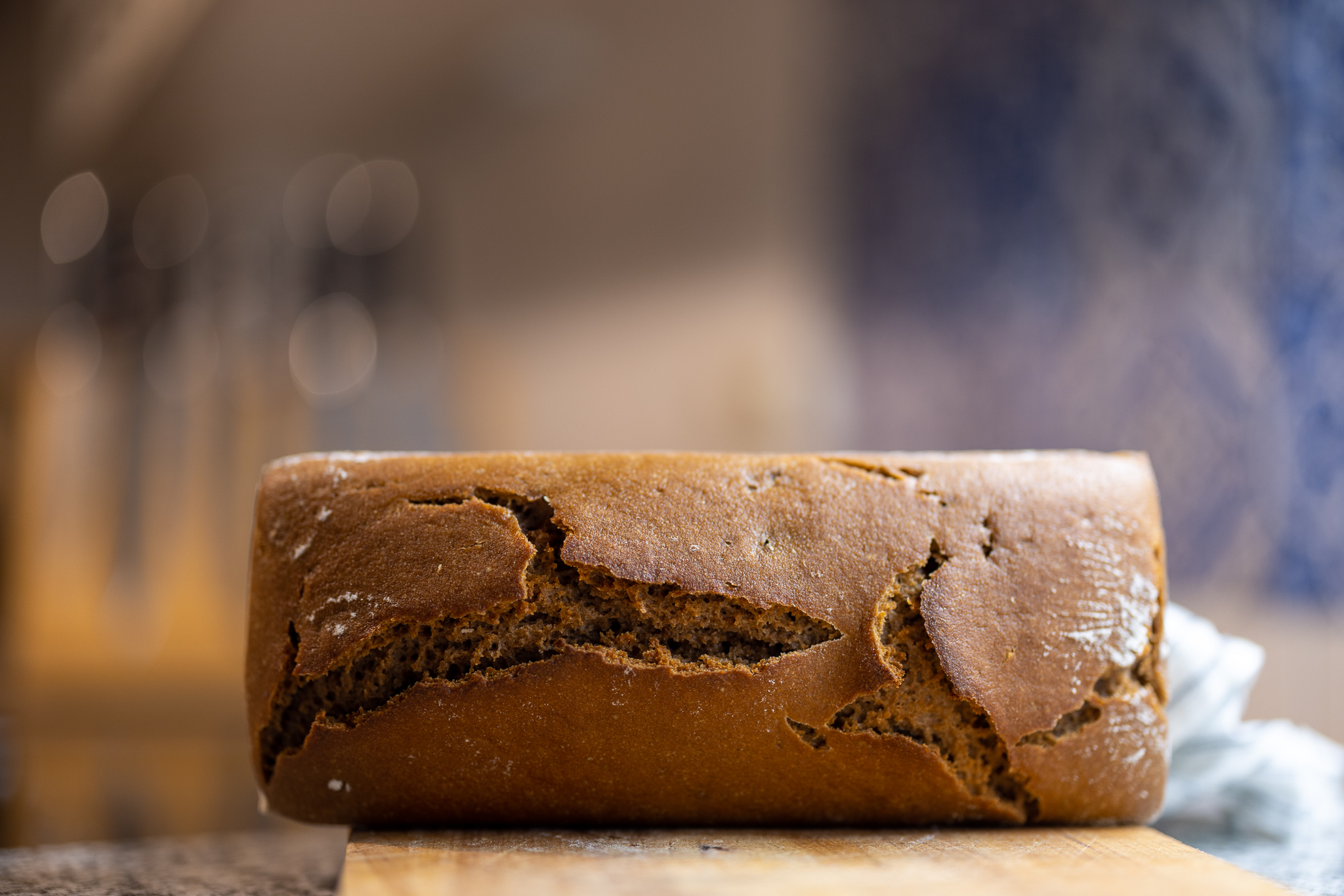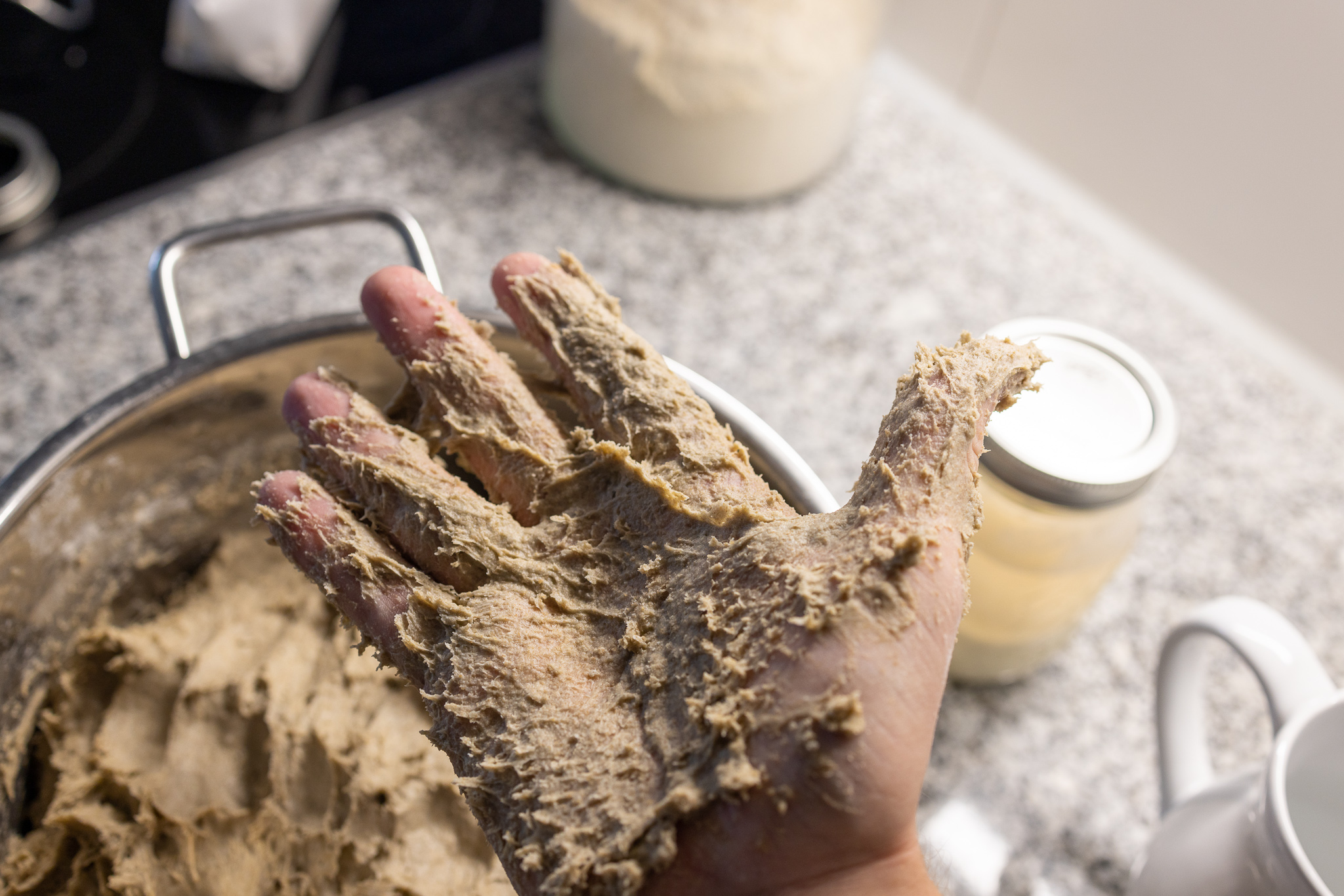8 Non wheat sourdough
In this chapter you will learn how to make a basic sourdough bread using non-wheat flour, basically all flour except spelt. The key difference between wheat and non-wheat flour is the quantity of gluten, the former feature a high amount of gluten, while the non-wheat flours do not.
The whole process (see Flowchart 8.1) is a lot easier: you mix the ingredients and wait for a certain period until the dough has reached the level of acidity that you like. Afterward, you shape the dough or pour it into a loaf pan. After a short proofing period, the bread can be baked. Due to the lack of gluten development, the final bread will feature a denser crumb compared to wheat, as you can see in Picture 8.4.
For non-wheat flours—including rye, emmer, and einkorn—no gluten development has to be done, meaning there is no kneading, no over-fermentation, and no issues with making flat bread. In the case of rye flour, sugars called pentosans prevent gluten bonds from properly forming [22].

This chapter will focus on making rye bread. The flour could be replaced with einkorn or emmer based on your preference.
The following recipe will make you 2 loaves:
| 1000 g | (100 %) | Whole rye flour |
| 800 g | (80 %) | Water at room temperature |
| 200 g | (20 %) | Sourdough starter |
| 20 g | (2 %) | Salt |
The sourdough starter can be in an active or inactive state. If it has been at room temperature for a week with no feedings then it will be okay, same if it has come right out of the fridge then still it will be no problem. The dough is very forgiving.
If you follow the suggested quantities from the recipe you are making a relatively wet rye dough. It’s so wet that it can only be made using a loaf pan. If you want to make a freestanding rye bread, consider reducing the hydration to around 60 %.

Mix together all the ingredients with your hands, or opt for a spatula to simplify things. Rye flour itself is very sticky and unpleasant to mix by hand, the dough will stick a lot to your hands. If you use a stiff starter, it could be easier to first dissolve it in the dough’s water, then add the other ingredients.

The goal of the mixing process is simply to homogenize the dough, there is no need to develop any dough strength. Once you see that your sourdough starter has been properly incorporated, your dough is ready to begin bulk fermentation.
You can bulk ferment the dough for a few hours up to weeks. By extending the bulk fermentation time, you increase the acidity the final loaf is going to feature. After around 48 hours, the acidity will no longer increase. This is because most of the nutrients have been eaten by your microorganisms. You could let your dough sit for longer, but it wouldn’t alter the final flavor profile by much.
I recommend waiting until the dough has roughly increased by 50 % in size. If you are daring, you can taste the dough to get an idea of the acidity profile, it will likely taste very sour. However, a lot of the acid will evaporate during the baking process, therefore the final loaf will not be as sour as the dough you are tasting.

Once you are happy with the acidity level, proceed to dividing and shaping your dough. If you made a drier dough, use as much flour as needed to dry the dough a little bit and form a dough ball. There is no folding the dough. All you do is tuck it together as much as is needed to apply the shape of your banneton.
Shaping might not be possible if you opt for the wetter dough. Carefully spread the dough with a spatula in your greased loaf pan, wetting the spatula to make this process easier. Spread it until the surface looks smooth and shiny.
For proofing, I recommend waiting around 60 minutes. An extended proofing period does not make sense unless you want to further increase the dough’s acidity. The dough will not become fluffier the longer you proof. With the short proofing period, however, the dough will become a bit more homogeneous. This way the final bread looks more uniform. The proofing period also allows the dough to fully extend and fill the edges of the loaf pan. I also like to move the dough to the fridge for proofing. The dough stays good in the fridge for weeks. You can proceed and bake it at a convenient time for you.
Once you are happy with the proofing stage, proceed and bake your dough just like you’d normally do, more details can be found in Chapter 10. One challenging aspect of using a loaf pan is to make sure that the center part of your dough is properly cooked. For this reason, it is best to use a thermometer and measure the internal temperature. The bread is ready once the internal temperature reaches 92 °C (197 °F). I recommend removing the bread from the loaf pan once it reaches the desired temperature, then continue baking the loaf without the pan and steam. This way you achieve a great crust all around your loaf, and can bake as long as you like until you have achieved your crust color of choice. The darker, the more crunchy the crust and the more flavor it offers. If you feel your dough might have been overly acidic you can extend the baking time, as the longer you bake, the more acidity will evaporate.
This is one of my favorite breads to bake which I eat on an almost daily basis. The effort required to make bread like this is much lower compared to a wheat-based dough. In some cases, I extend the recipe and add additional sourdough discard to the dough. You can add as much discard as you like. The resulting bread will have a very complex but delicious flavor profile.
